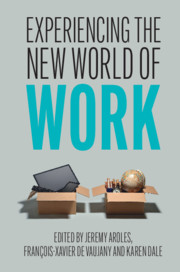Book contents
- Experiencing the New World of Work
- Experiencing the New World of Work
- Copyright page
- Contents
- Tables
- Contributors
- Foreword
- Introduction
- Part I Experiencing at Work
- 1 Embodied Inter-Practices in Resonance as New Forms of Working in Organisations
- 2 Wherever I Lay My Laptop, That’s My Workplace
- 3 ‘So Many Cool Things to Do!’
- 4 Experiencing Making
- Part II Digital Platforms and the New World of Work
- Part III Politics, Imaginaries and Others in the New World of Work
- Conclusion
- Afterword
- Index
- References
4 - Experiencing Making
Silence, Atmosphere and Togetherness in Makerspaces
from Part I - Experiencing at Work
Published online by Cambridge University Press: 24 December 2020
- Experiencing the New World of Work
- Experiencing the New World of Work
- Copyright page
- Contents
- Tables
- Contributors
- Foreword
- Introduction
- Part I Experiencing at Work
- 1 Embodied Inter-Practices in Resonance as New Forms of Working in Organisations
- 2 Wherever I Lay My Laptop, That’s My Workplace
- 3 ‘So Many Cool Things to Do!’
- 4 Experiencing Making
- Part II Digital Platforms and the New World of Work
- Part III Politics, Imaginaries and Others in the New World of Work
- Conclusion
- Afterword
- Index
- References
Summary
Craftsmanship, making and do-it-ocracy are prominent elements of the so-called new world of work. In this chapter, we describe the ‘experience of making’ in two makerspaces, one located in France and the other in the United States. In particular, we focus on three concepts – silence, atmosphere and togetherness – in order to flesh out, or make visible, the specificities of Do-It-Yourself (DIY) and Do-It-Together (DIT) processes in makerspaces. We mobilise Merleau-Ponty’s work and an aesthetic perspective on time and place to delve into the experience of making. This leads us to propose the concept of New Collaborative Experiences (NCE), which we define as new modes of feeling and expressing the self and the world in a context that requires a collective production and coordination, as a way of illuminating our two ethnographic accounts.
- Type
- Chapter
- Information
- Experiencing the New World of Work , pp. 84 - 106Publisher: Cambridge University PressPrint publication year: 2021
References
- 3
- Cited by

